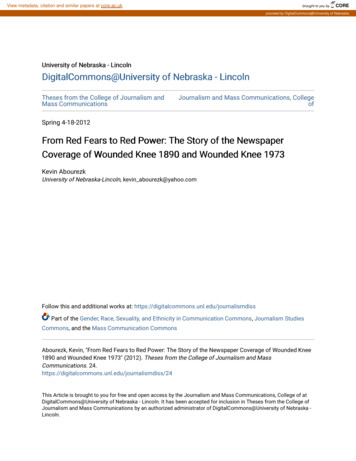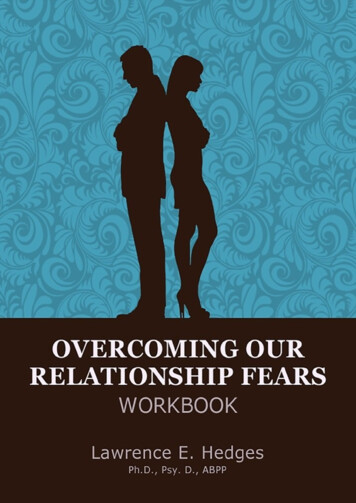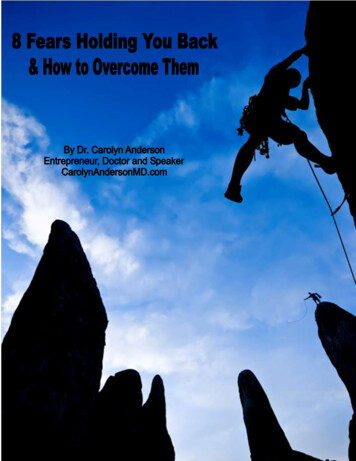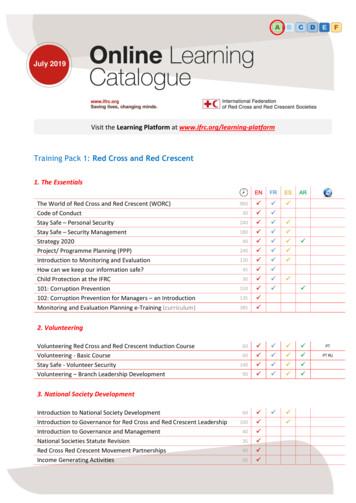
Transcription
View metadata, citation and similar papers at core.ac.ukbrought to you byCOREprovided by DigitalCommons@University of NebraskaUniversity of Nebraska - LincolnDigitalCommons@University of Nebraska - LincolnTheses from the College of Journalism andMass CommunicationsJournalism and Mass Communications, CollegeofSpring 4-18-2012From Red Fears to Red Power: The Story of the NewspaperCoverage of Wounded Knee 1890 and Wounded Knee 1973Kevin AbourezkUniversity of Nebraska-Lincoln, kevin abourezk@yahoo.comFollow this and additional works at: https://digitalcommons.unl.edu/journalismdissPart of the Gender, Race, Sexuality, and Ethnicity in Communication Commons, Journalism StudiesCommons, and the Mass Communication CommonsAbourezk, Kevin, "From Red Fears to Red Power: The Story of the Newspaper Coverage of Wounded Knee1890 and Wounded Knee 1973" (2012). Theses from the College of Journalism and MassCommunications. 4This Article is brought to you for free and open access by the Journalism and Mass Communications, College of atDigitalCommons@University of Nebraska - Lincoln. It has been accepted for inclusion in Theses from the College ofJournalism and Mass Communications by an authorized administrator of DigitalCommons@University of Nebraska Lincoln.
FROM RED FEARS TO RED POWER: THE STORY OF THE NEWSPAPERCOVERAGE OF WOUNDED KNEE 1890 AND WOUNDED KNEE 1973byKevin C. AbourezkA THESISPresented to the Faculty ofThe Graduate College of the University of NebraskaIn Partial Fulfillment of RequirementsFor the Degree of Master of ArtsMajor: Journalism and Mass CommunicationsUnder the Supervision of Professor Charlyne BerensLincoln, NebraskaApril, 2012
FROM RED FEARS TO RED POWER: THE STORY OF THE NEWSPAPERCOVERAGE OF WOUNDED KNEE 1890 AND WOUNDED KNEE 1973Kevin C. Abourezk, M.A.University of Nebraska, 2012Adviser: Charlyne BerensThis thesis examines newspaper coverage of the Wounded Knee massacre, whichoccurred in December 1890, and the takeover of Wounded Knee, S.D., by members ofthe American Indian Movement in 1973. In 1890, 21 reporters covered the massacre inwhich 25 soldiers and 250 Indians were killed, while dozens of radio, television andnewspaper reporters covered the 1973 siege in which two Indians were killed. Somehistorians say newspaper coverage leading up to the massacre, including sensational,false stories about Indians attacking settlers, contributed to Indian agent Dr. D.F. Royer’scalling upon the military to suppress a feared Indian rebellion, a decision that led to themassacre at Wounded Knee. The mostly white journalists who covered the massacrelargely failed to interview the Indian survivors, many of who couldn’t speak English. In1973, journalists provided much more balanced coverage of the Indian activists’ andgovernment’s perspectives. The Indians in 1973 actively manipulated the media, andmany Indian reporters even covered the event for Indian publications.
1ContentsIntroduction2Chapter I: The literature of Wounded Knee I and II6Flocking to Wounded Knee9A Return to Wounded Knee14An evolving Indian voice21Chapter II: Wounded Knee 189022Going to War23Feeding the Fear25Death of a Chief31Reporters on the Frontlines34A Senseless Tragedy41Chapter III: Wounded Knee 197343The romantic Indian49Of hostages, images and history52Army of journalists61Reassessing history66Endnotes75
2IntroductionThe obelisk bears names, so many names engraved deeply into its gray stone skin.Names of men, women and children. Names like Wolf Skin Necklace, Bird Shakes andBig Skirt.To many who have passed through the arched gate at Wounded Knee Cemetery,these names are simply the slaughtered, a tired and hungry band of Miniconjou Lakotakilled on that unseasonably warm day in December 1890. To the Lakota, they are theoyate, the people. So much more than frozen, stiff bodies found in the dirty snow. Somuch more than faceless names on a stone marker.The last conflict of the Indian Wars began Dec. 28, 1890, when the SeventhCavalry caught Chief Big Foot’s band of Miniconjou Sioux near Wounded Knee Creekon the Pine Ridge Indian Reservation. The Seventh was the same division that had beenwiped out at the Little Bighorn Battlefield along with its flamboyant commander, Lt. Col.George Armstrong Custer, 14 years earlier by Lakota, Cheyenne and Arapaho underChief Sitting Bull and Crazy Horse. On Dec. 29, as the cavalry soldiers attempted todisarm the Indians, a shot rang out and all hell broke loose. About an hour later, nearly 25soldiers and 250 Indian men, women and children lay dead or dying.And so the Lakota returned to Wounded Knee in 1973, to fight again for theirpeople and to honor the sacrifices made by so many so that their children’s childrenmight live. They brought with them the eyes and ears of a nation that had watchedwearily for nearly a century as the Lakota and their Indian brethren wasted away onreservations, their cultures and religions stifled by governmental and religious
3oppression, their governments corrupted by tribal leaders and federal officials seeking tocontrol and gain economic benefit from tribes. 1For this paper, I have examined daily newspaper coverage of the 1890 WoundedKnee massacre and the 1973 takeover of Wounded Knee, as well as literature that waswritten after both events, including books, magazine articles and articles written forscholarly journals. I focused my examination of the 1890 massacre on five Nebraskanewspapers: the Omaha Daily Bee, the Omaha World-Herald, the Lincoln Evening News,the Nebraska State Journal (Lincoln) and the Dawes County Journal (Chadron). All fiveof these newspapers sent reporters to the Pine Ridge Indian Reservation to cover theevents leading up to the massacre, and three of them had reporters at or near WoundedKnee Creek when the massacre occurred.I focused my examination of the 1973 Wounded Knee siege on the OmahaWorld-Herald, the Lincoln Evening Journal, the Lincoln Star, the New York Times andthe Chadron Record. Each of those newspapers sent correspondents to cover the siege.However, unlike the 1890 siege, none of those newspapers had reporters at the scenewhen Indian activists took over the village of Wounded Knee. That’s likely because thegrinding violence between the Indian activists and supporters of Oglala Sioux PresidentDick Wilson that eventually led to the takeover didn’t offer the same sensational imagesand rich historical context that the takeover of Wounded Knee readily provided.To better understand both events, I also have examined literature written aboutboth events. Most of the literature written after the Wounded Knee massacre has comefrom historians. The literature written after the 1973 siege has included books written byhistorians and by several Indian activists involved in the siege who attempted to present
4their version of the 1973 event. The literature that has examined the 1973 takeover alsohas examined the methods and impact of television coverage of that event. Much of theliterature I examined that was written about the media’s methods of covering theWounded Knee siege has come from magazines, such as Harper’s and Time.Based on the literature that has been written about the Wounded Knee massacre, Iexpected to find some stereotypical terminology used to describe Indians, as well as ageneral tendency toward sensationalism by the newspapers when it came to describingthe growing tension on the Pine Ridge Indian Reservation. I certainly found stereotypicalterminology used to describe the Indians but also found an even greater degree ofsensationalism by the newspapers than I expected to find. I also found that thenewspapers tended to criticize either military or government officials depending on thenewspapers’ political bent and that few reporters interviewed Indians either before orafter the massacre.Based on the literature that has been written about the Wounded Knee siege of1973 by non-Indian authors, I expected to find some Old West stereotyping by thenewspapers I examined, as well as a tendency by reporters to glorify the Indian activists’actions. I certainly found some stereotyping of Indians by newspapers but not as much asI expected, and I did find evidence of bias toward the Indian activists and against thegovernment and tribal government officials opposed to the activists. I also found thenewspapers covered the siege like they would a war with a strong focus on the weaponsused and ammunition expended by both sides. Reporters interviewed both the Indianactivists and government officials nearly in equal measure, except when the reporterswere denied access to Wounded Knee.
5As they flocked to the promise of conflict in the days before the Wounded Kneemassacre in 1890, reporters swarmed the Pine Ridge Reservation again in 1973 whenmore than 200 Oglala Lakota and members of the American Indian Movement enteredthe village of Wounded Knee and declared their intentions to remain there until theirconcerns about government corruption were addressed. I expected the method and impactof the news reporters’ coverage of the 1890 and 1973 events to be very different.
6Chapter I: The literature of Wounded Knee I and IIThe literature that has examined news coverage of the Wounded Knee massacreof 1890 has primarily come from historians such as Elmo Scott Watson, who wrote in aSeptember 1943 article for Journalism Quarterly of “newspaper jingoism” and “yellowjournalism” and how newspapers’ efforts to sell papers by sensationalizing tension on thePine Ridge Reservation contributed to the conflict between soldiers and Indians. Laterhistorians, including Dee Brown, author of “Bury My Heart at Wounded,” and WilliamS.E. Coleman, author of “Voices of Wounded Knee,” have examined the broader originsand implications of the conflict, including news coverage as a mostly sideline issue thatwas not among the factors that caused the massacre.While much has been written about the Wounded Knee massacre, only in recentyears has a focus on the contribution of news coverage to the conflict emerged amonghistorians. However, at least one historian, Oliver Knight, author of “Following theIndian Wars,” wrote a chapter on news coverage of Wounded Knee in his 1953 book thatdescribed the state of newspaper coverage during the late 19th century as a competitiveperiod marked by newspapers being willing to report sensational rumors in order to winwider readership.As late as the 1890s, most newspapers aligned themselves with and were fundedby political parties, a practice that had begun after 1765, when conflict with Englandheated up, according to authors Michael Schudson and Susan E. Tifft, who wrote anessay on the state of journalism in the late 19th and early 20th centuries for the 2005 book“The Press.” 93 However, by the time the Civil War ended in 1865, newspapers had begun
7to become profitable enterprises and began to compete with each other for readersthrough sensational news coverage rather than political pandering. 93When publisher William Randolph Hearst arrived in New York in 1895, heintroduced comics, sensational news coverage and self-promotion to compete with NewYork World publisher Joseph Pulitzer. Both publishers called for war with Spain in thelate 1890s. However, while some historians have blamed Hearst and Pulitzer for causingthe Spanish-American War, Schudson and Tifft argued that contention is mostly theresult of Hearst gleefully taking credit for the war. “The pull of dollars and the popularityof sensationalism helped move newspapers away from parties,” according to Schudsonand Tifft. 93 Reporters who arrived at Wounded Knee in 1890 would bring with them thissame inclination toward sensationalism.Later historical books, such as “Eyewitness at Wounded Knee” by Richard E.Jensen, R. Eli Paul and John E. Carter (1991) and “The Frontier Newspapers and theCoverage of the Plains Indian Wars” by Hugh J. Reilly (2010), have looked much moreskeptically at the efforts of correspondents on the cold plains of South Dakota in 1890and 1891. Later historians, such as Watson and Rex Alan Smith, have demonstrated thatthe media contributed to the fear and paranoia felt by many settlers and governmentagents in the weeks and months leading up to the massacre through sensational newscoverage that often relied on rumor and hearsay. That fear, in turn, led a nervous Indianagent to call military units to the reservation.As for the Wounded Knee siege of early 1973, the literature that has examinednews coverage of that event has included magazine articles written during and shortly
8after the event in publications such as “Harper’s Magazine” and “National Review” thatlambasted the media for becoming focused on a staged “pseudo-event.”That literature also has included books written many years later by participants onboth sides of the event, including American Indian Movement leaders Russell Means,who wrote “Where White Men Fear to Tread,” and Dennis Banks, author of “OjibwaWarrior,” as well as Stanley David Lyman, former Pine Ridge, S.D., Bureau of IndianAffairs superintendent and author of “Wounded Knee: A Personal Account.”Historians also have examined news coverage of the siege, including Mary AnnWeston, author of “Native Americans in the News: Images of Indians in the TwentiethCentury Press,” who found newspapers and magazine often relied on western stereotypesof cowboys and Indians in their coverage.Including the voices of Indian leaders distinguishes the literature that examinescoverage of the 1973 siege from coverage of the 1890 massacre. Those Indian leadershave attempted to allay criticism of their alleged “handling” of the media during the siegeand portray their endeavors in the most heroic light by denying they posed certain eventsand took hostages during the event.
9Flocking to Wounded KneeBy late 1890, the Indian Wars were drawing to a close. Custer had been whippedat the Little Bighorn, and the Lakota leaders who had been architects of his demise,Crazy Horse and Sitting Bull, were dead. Reporters came to document what was shapingup to be one last act of resistance by Lakota taking part in the Ghost Dance.Of the 21 reporters who came to the reservation, just three witnessed the actualmassacre: William F. Kelley of the Nebraska State Journal, Charles W. Allen of theChadron Democrat and Charles H. Cressey of the Omaha Daily Bee. Kelley, according towitnesses, took a much more direct role in the conflict, emptying his revolver at a warriorwho charged him and then picking up a soldier’s rifle and killing at least two moreIndians. 2The correspondents who flocked to the reservation were working in a period thathistorian Oliver Knight called “New Journalism,” a time he said was defined bynewspapers struggling for circulation and competing aggressively for readers, oftencasting aside accuracy in favor of sensationalism. 3Characterizing the situation, Knight wrote:Unverified rumors became reports from reliable sources, idle gossip was reportedas fact. As the distortion of an imminent Indian outbreak spread across thenewspapers, terror in turn swept across Nebraska, the Dakotas and even as far eastas Iowa. Mass hysteria sent settlers flocking into the nearest railroad towns,telling stories – made of whole cloth – about murder, scalping and desolation. 3In all, 21 correspondents – more than had covered all of the other Indian Warcampaigns before then – gathered at Pine Ridge, S.D., from as far away as Washington,D.C., and as near as Chadron – 30 miles away – to tell the story of the final clash betweenthe U.S. Army and “red savages.” 3 Their dispatches made it clear that the Ghost Dance
10signaled the beginning of yet another Indian uprising, despite credible claims from theIndians and other witnesses to the dancing who said it was a non-violent, if misguided,attempt to revive the dying culture of the plains tribes. 2Historian Coleman described many instances of inaccuracy and exaggeration onthe part of reporters at Wounded Knee. He described conflicting dispatches sent from thereservation and nearby communities, including alarmist reports of “roving bands ofSioux” by the Rapid City Journal on Nov. 23, 1890. 4 Only a day later, the Omaha DailyBee quoted Bishop Hare of the Episcopal church, who had done missionary work amongthe Lakota for nearly a decade, as saying the Ghost Dance would run its course if allowedto continue uninterrupted. If the military intervened in the dance, however, “It willprecipitate war with absolute certainty,” Hare warned. 4Several historians, including Watson and Coleman, described how newspaperscloser to the reservation called for calm in the face of sensational reports by regional andnational media about growing tension. The Custer Chronicle of South Dakotacomplained: “The Indian scare continues unabated, having been intensified rather thandiminished by the startling and (in) many instances highly exaggerated reports emanatingfrom newspaper correspondents at the front who seem inclined to report the situation inits most alarming possible phrase.” 4 Residents of Chadron, less than 30 miles from PineRidge, got so fed up with the alarmist news reports that they circulated a petitiondemanding the Daily Bee and the World-Herald stop printing such “incredible andprovocative reports.” 5Some historians, including Rex Alan Smith, have gone so far as to call theirsensational coverage a contributing factor to the massacre. 6 That coverage could be seen
11in such alarmist front page headlines as: “THE TURBULENT REDS, Latest Intelligencefrom the Scene of the Threatened Outbreak” (Omaha Daily Bee, Nov. 22, 1890) and“Squaws Swarming at Pine Ridge, Each One Armed With a Knife” (Daily Bee, Dec. 17,1890). But once the shooting had ended, those same reporters began to blame the samesoldiers and government agents they had earlier described as valiant defenders of theplains. The “treacherous red devils” and “murderous savages,” as they had called theIndians prior to the massacre, then became the hapless victims of an uncaring andbloodthirsty government and military war machine that had starved them and thenslaughtered them. 2While Watson pulls no punches when it comes to criticizing press coverage, helays most of the blame for the massacre on the “timorous and inept agent at Pine Ridge,”Dr. D.F. Royer. He describes Royer as a political appointee who lacked the skills tohandle explosive situations. “Royer played into the hands of these volunteerpropagandists by bombarding his superiors in Washington with requests that troops besent to Pine Ridge.” 2Historians Richard E. Jensen, R. Eli Paul and John E. Carter took a differentapproach to examining news coverage of Wounded Knee, focusing on the imagesproduced by the photographers there. Their book, “Eyewitness at Wounded Knee,”examines the personal histories of those photographers, as well as the quality of theirwork and their motivations, which primarily consisted of profit. In 1890, selling photos ofthe dying Plains Indian culture was lucrative, especially when the photos illustratedconflict. As a result, the photographers who captured images of “people frozen in death,on a land frozen by cold” made their photos not as documents attesting to the Indians’
12decline but as a means to “feed the news-hungry public.” In their efforts to give their5viewers what they wanted – images of savage Indians fighting for their way of life –“Fact became subordinate to stereotype.” 5In addition, the reporters who arrived at Chadron and other communities near thereservation in late 1890 colored their dispatches to “conform to the political affiliations ofthe journals they represented.” 2 The Democratic newspapers saw the rising tension as theresult of the corrupt and inefficient administration of Indian affairs under RepublicanPresident Benjamin Harrison. Republican newspapers viewed the potential uprising asthe result of the failed Indian policies of former Democratic President Grover Cleveland.2That politically tinted coverage could be seen most clearly in the two most prominentnewspapers in Omaha, Neb. – the Republican-leaning Omaha Daily Bee and theDemocratic-leaning Omaha World-Herald. While the Daily Bee heralded the efforts ofIndian agent Royer, even deflecting criticism of Royer from the World-Herald, theWorld-Herald made it clear that nearly all of the blame for the impending violence restedwith Royer and the inept government officials at Pine Ridge. 9 The World-Herald,meanwhile, glorified the military’s efforts and called for military leaders to take controlof the reservation’s affairs. 9Perhaps the most eloquent of those voices calling for military control of PineRidge was Suzette La Flesche, one of the nation’s first female Indian reporters. AnOmaha tribal member, she became an advocate for the Indians at Pine Ridge andappealed on their behalf for military commanders to replace Interior Departmentleadership at the reservation.
13“I am the only Indian speaking to the public through the press for the Indians, andI demand in the name of the race and for their welfare that it shall be done,” she wrote.La Flesche’s presence at Wounded Knee would presage the eventual creation ofIndian media and the evolution of Indian activism that would seek greater control of newscoverage during the turbulent 1960s and 1970s.
14A Return to Wounded KneeIn February 1973 – drawn by images of Indians hoisting rifles and shaking theirfists – the national media fixated quickly on the looming violence as hundreds of FBIagents and U.S. marshals surrounded the lightly armed Wounded Knee occupiers withtanks and armored personnel carriers. The scene echoed that other great conflict that hadscarred this land, that day in 1890 when shots rang out near a creek named WoundedKnee.“It virtually guaranteed them a good press,” reporter Terri Schultz noted cynicallywhen commenting on the activists’ choice of ground in a June 1973 article in Harper’sMagazine. 11A March 1973 article in Time described how the stunning images coming fromWounded Knee created a kind of trap for the media, especially TV news stations, whichwere lured to the reservation and then forced to remain there throughout much of the 71day siege. 12 Time quoted Interior Department Aide Charles Soller as saying: “It couldhave been settled in a week if it weren’t for this horde (of reporters).” Newsmen watched“helplessly as the thin line between covering and creating news wavered,” according tothe Time article, “Trap at Wounded Knee.” 12Whether already aware of Wounded Knee’s history or reminded by the Indianactivists surrounded there, newspaper, television and radio reporters took every possibleopportunity to compare the two conflicts. Their coverage, at least at first, focused on theromantic noble warrior fighting valiantly against an oppressive, powerful government. 13But the government’s decision to enforce the blockade around Wounded Knee severelylimited press access and curtailed the occupiers’ efforts to get their message to the outside
world.1315Thus, the media grew tired of the lack of stunning images and engaginginterviews with activists and began to contemplate what drew them to Wounded Knee inthe first place.Headlines like “Bamboozle Me Not at Wounded Knee,” “Trap at Wounded Knee”and “Of Fallen Trees and Wounded Knees” reflected a growing skepticism by thenational media over the occupiers’ theatrics. The Chicago Tribune described the Indiansas militant criminals, though The New York Times called them “rebels” and urgedpatience by the government. 13 Some reporters called the action at Wounded Knee makebelieve, thus allowing their readers to view the issues as fictional. 13 And few, if any,reporters actually investigated the charges made by the occupiers against Oglala SiouxChairman Dick Wilson, whom the activists described as a criminal who had killedwithout provocation many traditional Lakota and embezzled from his tribe. 13However, the occupiers failed to adequately communicate to the American publicthe vast, complex changes in Indian policy they sought, a failure that hurt their cause,according to some historians. 14 Schultz of Harper’s described the conflict betweenWilson and the activists as “not all that complicated,” as basically a struggle between apower-hungry tribal chairman and a bunch of alcoholic, equally power-hungrymilitants.11Those reporters who arrived at or near Wounded Knee covered the event as theywould a war, describing in great detail the arms that both sides used and the daily tit-fortat between the two sides. 13 Too often, their coverage lacked context, both cultural andhistorical. Reporters routinely evoked western images of cowboys and Indians dueling onthe plains. 13
16The Indians reinforced those stereotypes, according to some magazine writers atthe time. “They dress and act as if they believe everything the white man has writtenabout them,” Schultz wrote for Harper’s. 11 She described activists directing cameramenand restaging events that reporters missed, as well as parading before the media“hostages” who later turned out to be willing participants in the occupation. 11 Writing forthe National Review in April 1973, author Victor Gold described a young Indian manguarding a roadblock who had to be reminded that he didn’t look very warlike with “anexpensive camera dangling next to his rifle. So he put the camera aside as he posed as awarrior for a photograph.” 16Gold assailed the Native American activists’ handling of media as a desperateattempt to revive a dying form of political theatre. “It is like watching the Dead End Kidsafter they became the East Side Kids; a performance of ‘Streetcar’ with Jon Voightplaying the old Brando role; or a rendition of the new Brando non-accepting an Oscarwith Sandra Dee standing in for Sacheen Littlefeather,” Gold wrote. 16 “What’s left towatch is only the final, banal exercise of an overexposed political art form.”In reality, Schultz wrote, the activists were anything but real Indians. Instead, theywere urban Indians who knew little about their traditional cultures and, by and large,couldn’t speak their Native American languages. She lampooned the activists’ inability toput up a tipi or shoot and kill a cow to eat. 11Still, others blamed stereotypical depiction of Indians in film and thegovernment’s neglect of tribes for their deplorable conditions. When a young Indianwoman named Sacheen Littlefeather stepped up to the microphone at the March 1973Oscars, she informed those in the audience and those watching from home that Marlon
17Brando would not be accepting the award for best actor for his role in “The Godfather”because of how badly the government and the media had treated Indians. 92 “He veryregretfully cannot accept this very generous award, and the reasons for this being are thetreatment of American Indians today by the film industry, excuse me, and on television inmovie re-runs and also with recent happenings at Wounded Knee.” 91 Brando, throughLittlefeather, expressed support for the activists at Wounded Knee.Schultz and many other reporters at the time, however, lapsed into more modernstereotypes of Indians as drunks and impoverished. Schultz described how militants andtribal chairman Wilson’s family drank heavily as they were being interviewed. 11 Shethen described one of the lead activists as a poor man with bad teeth and a Napoleoncomplex. Schultz wrote: “Standing in the rubble behind his house the next morning, feetspread, arms crossed, the four remaining teeth in his mouth gleaming in the sun, AaronDeSersa tells a group of reporters: ‘I have ordered the caravans to come from St. Louis,Des Moines, St. Paul and Oklahoma, to avenge the firebombing of my house by Wilson’sgoon squads.’” 11Schultz pointed out that a state fire marshal later determined that faulty wiringcaused the fire in DeSersa’s home, not a firebomb. But Schultz wasn’t alone in herdemeaning descriptions of Indians. The Chicago Daily News described how manyreservation residents “don’t seem to mind” being poor, thus portraying Indians as adegraded people content with conditions that others would find intolerable. 13 At the sametime, local media largely focused their coverage on interviews with government officialsand non-Indians who expressed fear of spreading violence by militants. Schultzinterviewed James Kuehn, longtime executive editor of the Rapid City Journal, who told
18her: “We’re so close to the situation and things are so tense, you can’t say anything aboutthe Indians without offending somebody.” 11Historian Weston described the 1960s and 1970s as a period of Americanjournalism marked by a sea change in coverage of Indians. Unlike in 1890 and 1891,when just one Indian reporter, Suzette La Flesche, could be found to speak on behalf ofthe Indians killed at Wounded Knee, a century later, Indians had established their ownmedia and had access to mainstream media. 13 They could call on such Native Americanintellectuals as author Vine Deloria and Mohawk activist Richard Oakes to speak forthem in such hallowed pages as The New York Times Magazine. 13Indians had become their own spokespeople and exercised influence on thehighest levels of government. They also could, and did, write their own version of theoccupation’s history. Activists like Russell Means, Dennis Banks and “Lakota Woman”author Mary Crow Dog painted their own portraits of the events of early 1973. This was afar different Indian than the one the Seventh Cavalry encountered and destroyed atWounded Knee in 1890. Rather than sit mute as their ancestors did when the media toldthe story of the 1890 massacre, these Indians would attempt to rewrite history, to explaintheir actions themselves – without media like newspapers, radio or television.In his autobiography, “Ojibwa Warrior,” Banks attempted to portray the takeoveras approved by traditional Native Americans, an assertion no dou
historians, including Dee Brown, author of "Bury My Heart at Wounded," and William S.E. Coleman, author of "Voices of Wounded Knee," have examined the broader origins . Indian Wars," wrote a chapter on news coverage of Wounded Knee in his 1953 book that described the state of newspaper coverage during the late 19. th.











